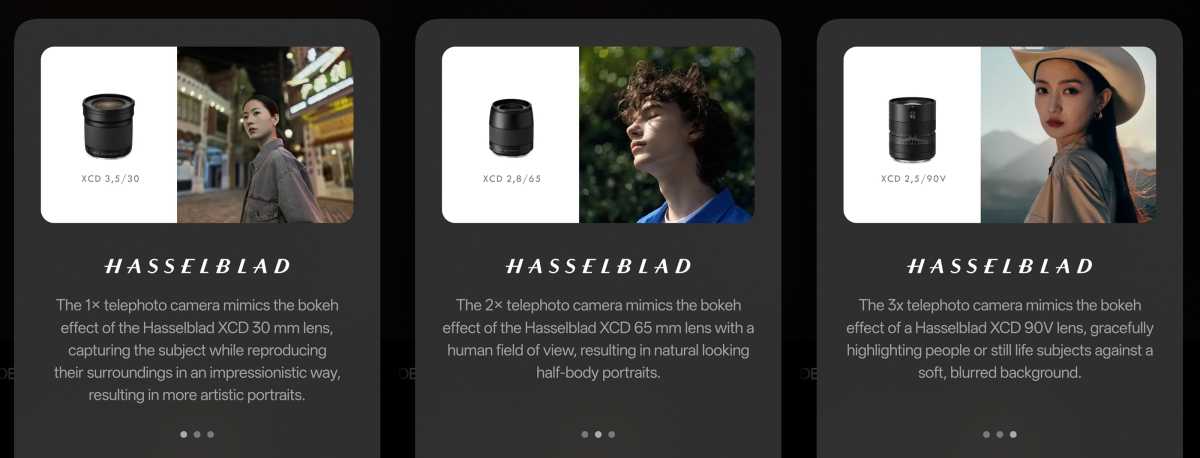Having just reviewed the OnePlus 13, it not only makes for a compelling start to 2025, it’s arguably the company’s most ambitious flagship smartphone to date; pushing in all areas, including the camera system.
OnePlus has once again turned to famed camera brand Hasselblad to help with the OnePlus 13‘s image tuning, while the underlying hardware is a natural evolution of the sensor setup we were introduced to on last year’s OnePlus 12.
Pair all that with new algorithms for addressing maladies such as motion blur, greater versatility across aspects like portrait mode and video capture, plus an upgraded AI image editing toolset and, on paper, the OnePlus 13’s camera system looks like a force to be reckoned with.
You can pre-order it now but after a month of shooting with it and over 150 photos closely examined, how has it fared in the real world?
Camera hardware
At a component level, the OnePlus 13’s main camera system is fronted by the same 1/1.4-inch ƒ/1.6 Sony LYT-808 sensor (with OIS or optical image stabilisation), that OnePlus introduced on the OnePlus 12.
Despite being a 50Mp sensor (with 1.12μm pixels), the OnePlus 13 uses pixel binning to leverage larger 2.24μm pixels, resulting in 12.6Mp shots at a resolution of 4096 x 3072 in a 4:3 aspect ratio. So far, so familiar.
Where the 13’s camera system deviates from its predecessor’s is with the ultrawide and telephoto at play, which now match the lead sensor for megapixels, at 50Mp a piece. Samsung’s 1/2.75-inch ƒ/2.05 ISOCELL JN5 sensor accounts for the 120-degree ultrawide, while a 1/1.95-inch ƒ/2.65 Sony LYT-600 sensor sits behind the telephoto lens.

Foundry | Alex Walker-Todd
It’s this 3x optical zoom lens (also supported by OIS) which is arguably the most innovative aspect of the OnePlus 13’s photographic hardware.
Rather than making the phone’s camera bump larger, by relying on conventional smartphone periscope telephoto sensors that direct light through 90-degrees, the OnePlus 13 instead uses a triprism design. This allows for a larger physical sensor, whilst allowing the whole telephoto module to clock in 24% smaller and 30% lighter, compared to the 3x camera on the OnePlus 12.
The 13 relies on the same 32Mp 1/2.74-inch ƒ/2.45 Sony IMX615 front camera, leaving the ISP (image signal processor) within the phone’s top-tier Qualcomm Snapdragon 8 Elite chipset and that Hasselblad image tuning to help deliver superior selfies.
Camera features
Speaking of Hasselblad, OnePlus brands the setup on its latest flagship as the ‘5th-Gen Hasselblad Camera for Mobile’, with the most tangible elements of their collaboration found within Master Mode, which sits atop Pro mode (i.e. manual control), offering additional at-capture effects; including sliders for saturation, contrast and even a vignette.
XPan mode has become a staple of the brand’s Hasselblad-branded phones, letting you capture shots in the format’s signature distinct 2.7:1 aspect ratio, while the OnePlus 13’s portrait mode now functions across 1x, 2x and 3x magnification, with the bokeh at each focal length modeled after a trio of Hasselblad-made lenses; specifically the XCD 3,5.30, XCD 2,8/65 and the XCD 2,5/90V, in the case of the 3x telephoto.

Foundry | Alex Walker-Todd
Action Mode doubles the speed of the sensor output to 60fps, to better capture fast-moving subjects, but this time it’s bolstered by OnePlus’ latest Dual Exposure Algorithm, which merges short and long-exposure shots at capture simultaneously, to ensure final images are both crisp and bright.
Contrast and drama help keep shots from looking flat or false, and luckily those behind the tuning on the OnePlus 13’s camera understand this
The upgraded Clear Burst feature puts this into practice, by allowing for the full algorithm and HDR processing to be carried out on every shot taken within a burst, resulting in bright, crisp subjects, in spite of fast movement.
One small but long-standing user-requested camera feature finally arrives as part of the phone’s OxygenOS 15 user experience too: Livephoto. Meaning those who like a bit of motion at the point of capture for context, when looking back on their snaps, now have such an option.
General shooting samples
A lot of prominent entries among the best camera phones have skewed away from darkness.
By that I mean HDR processing from the likes of Apple, Samsung and especially Google, has gotten so good at dealing with shadows and higher-contrast scenarios that a lot of smartphone photography is clearer and brighter than ever, but inauthentic in its results.
Contrast and drama help keep shots from looking flat or false, and luckily those behind the tuning on the OnePlus 13’s camera understand this. While the HDR pipeline is still clearly in effect – subjects in shadow are still represented in shadow – just with better detail and less noise than previously. I think it makes for more compelling imagery overall and is closer in finish to more conventional photographic processing.
For the most part, colour accuracy and skin tones turn out well on the 13, with impressively consistent white balance, even against harsh lighting conditions, such as warm restaurant mood lighting.
The caveat is that greens, in particular, have a tendency to lose saturation, especially in high-contrast scenes, where the camera favours dropping exposure on the brightest parts of the frame, resulting in green hues losing vibrancy and appearing under-exposed.
Portrait mode samples
It’s great to be able to leverage portrait mode across all three of the phone’s rear sensors, with generally pleasant and consistent results that again carry good skin tones and colour reproduction.
Under scrutiny, edge detection around hairs and the like does appear to lag behind what select rivals are able to muster, however, if social media is your main destination, these kinds of issues aren’t likely to push you to throw out the shots you’ve captured.
Whilst I haven’t used any of Hasselblad’s high-priced own-brand cameras or the lenses the OnePlus 13’s system supposedly emulates, I think more work could be done to improve bokeh quality. The fall-off of the depth effect behind a subject, in particular, sometimes looks a little too harsh; appearing misaligned with the actual distance of elements from the lens.
Macro samples
On the topic of consistency, OnePlus phones have previously struggled to maintain colour accuracy with their macro cameras or shooting modes, and although this persists on the OnePlus 13, the effect is less prominent than I’ve ever seen it; particularly with out-of-box software (OnePlus has a habit of improving camera performance and fixing known inconsistencies after launch, via software updates).
This doesn’t stop the shots you can capture from being perfectly pleasing, regardless.
The phone defaults to the ultrawide, in order to let you get up close and personal with particularly small subjects. Results show a clear distinction between
Low light & night mode samples
In low light, the OnePlus 13 works hard to preserve colours and correctly expose subjects whilst managing white balance.
For unknown reasons, it would occasionally under-expose a scene (at which point I’d resort to night mode), but proved otherwise comfortable taking pleasing shots in dim conditions.
Up close, there’s a clear drop in detail definition when shooting in low light, however, results were otherwise pretty pleasing.
The phone can extend capture time automatically in low light, but for best results, it pays to switch the phone’s dedicated night mode, which can pull more details out of the darkest areas of the frame, while managing noise fairly effectively.
Selfie samples
When it comes to selfies, there’s a clear difference in image processing between the OnePlus 13’s front and back cameras. Perhaps as a result of having to compensate for the smaller, weaker, lower resolution sensor above the phone’s (excellent) display.
There’s evidently more heavy-handed processing at work when taking front-facing selfies, with face brightening that’s closer in style to that aforementioned ‘HDR look’ and not in keeping with the rest of the 13’s camera system.
As per the above comparison, the eyes really ‘pop’ when using the front camera, but colour and contrast lose accuracy as a result. If you’re after this more pronounced look, the 13 gives you the option, without forcing it on you, simply by slipping the phone around.
OxygenOS 15 added a trio of new AI image editing tools to the existing AI Eraser that was available on the OnePlus 12.
In testing, AI Eraser’s ability to camouflage unwanted elements has improved since launch, with a trio of intuitive controls to let you tap or lasso around subjects quickly and easily.
It was the AI reflection removal tool that I was most intrigued to test out and true to its name, it does a respectable job of adding clarity to shots with shiny surfaces in and is convincing enough that you’re unlikely to know if you were looking at an affected image.
The feature works best with well defined reflected sources, like shaped light shades or window panes, seemingly relying on contrast and edge detection to discern what’s a reflection and what’s behind the glass you’re shooting at.
It can’t act like a polariser, however, proving unable to remove the reflection of a bright cloud sky, in order to see past, into a building.
Are the OnePlus 13 cameras any good?
While there’s no denying that the OnePlus 13 possesses the company’s most accomplished camera phone to date, it still comes with one too many caveats to be considered as one of the best camera phones on the market right now – if you really care about the finer details.
Small inconsistencies in colour and detail retention – especially when the lights go down – hold it back from photographic supremacy.
At the same time, perhaps as a result of the Hasselblad partnership, the OnePlus 13’s camera isn’t as heavy handed as its competitors when it comes to HDR processing, which offers up a more authentic shooting experience; especially when it comes to the results.
New processes like its Dual Exposure Algorithm and Smart Burst are to be commended too, while fans of the brand will undoubtedly enjoy upgrades as part of Oxygen OS 15, like Livephotos, reflection removal and the rest of its new photographic AI tricks.











